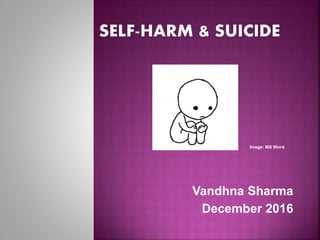
SH & SUICIDE xppt
- 1. Vandhna Sharma December 2016 Image: MS Word
- 2. “…self-mutilation is distinct from suicide…A basic understanding is that a person who truly attempts suicide seeks to end all feelings, where as a person who self- mutilates seeks to feel better” (Favazza, 1998). Intention Understanding
- 3. Defining self-harm Causes of self-harm Assessing self-harm Managing self-harm - Strategies Break Suicide risk assessment & crisis plan Suicide interventions Advice parents/carers Support services
- 5. Self injury is the intentional harm of one’s own body without conscious suicidal intent (Alderman, 1997; Favazza, 1998). Types of SH – this is not an exhaustive list Cutting Scratching Burning Biting Swallowing foreign objects e.g. drawing pins/glass Interfering with wound healing Swallowing toxic substances e.g. bleach SELF-HARM DEFINITION & FORMS
- 6. Muller, 2005
- 7. SH alone is not a MH diagnosis. Is a symptom associated with a number of mental health disorders: Anxiety Eating difficulties Depression Post Traumatic Stress Disorder Personality Disorder Substance Use
- 8. Can only be based on what is reported 13% of young people may try to hurt themselves on purpose at some point between the ages of 11 and 16 In past 4 years has been 70% increase in 10-14 year olds attending A&E for self- harm. One in twelve children and young people are said to self-harm - www.nice.org.uk/guidance/cg16/evidence/cg16-selfharm- full-guideline-2 - http://www.hscic.gov.uk/media/14858/Self- HarmAreaTeamagegender2011- 2014/xls/SelfHarm_AreaTeam_age_gender_2011-2014.xlsx
- 9. Case study: You are working with 16 year old Max for cannabis use. Lives at home with family and attends school. He discloses to you that a few days ago he cut his leg. 1/ What is your response? (what do you say? How do you feel? What is the look on your face?) 2/ How do you assess the risk? (What questions do you ask? What advice do you give?) -Discuss in groups of 3 for 20 mins -Feedback together, 10 mins
- 10. Calm Eye contact Thank them for sharing Ask about it. Show you care. Acknowledge the distress Don’t discourage self-injury If appropriate, ask to see injury Helping: What to Do (Alderman, 1997)
- 11. Their account Intention and understanding When did they cut What did they cut with Where did they cut Deep or superficial cuts/scratches Has the cut healed Signs of infection Have they done it before Are they ok to show you the cut/s Are they planning on cutting again
- 12. try not to cut over old cuts Clean area bandages and plasters If you cut an artery or bleeding won’t stop: ambulance Don’t cut with glass Give crisis numbers and websites Alternatives to SH docs (handout) My Plan -crisis doc (handout)
- 13. STRATEGIES TO MANAGE DISTRESS Chill Out Techniques Music Bath Call friend Punch pillow Hug Funny film Run Breathe
- 16. Preparing yourself Can be scary and overwhelming Look after yourself Supervision Ask for help Use My Plan – on youself
- 17. More than one million people commit suicide annually across the globe. 60-70 young people under the age of 18 die by suicide in England each year. One in Four (26%) young people in the UK experience suicidal thoughts ChildLine (UK) revealed that since 2010 there has been a 116% increase in children talking about suicide Only 14% of suicides aged under 20 have been in contact with specialist mental health services Youth Suicide – Young Minds Website
- 18. LAC Young Offenders Disability LGBT BME Acting without thinking through consequences Having access to weapons/pills/rope etc.. Chronic pain Money problems Little hope for future Thoughts/intent to hurt others Struggle to solve problems Perfectionist tendencies
- 19. Someone has decided to kill themselves and made a plan If they have sorted out responsibilities Completed a suicide note Said goodbye to people Given away belongings they love Announced it online
- 20. told you support from family and friends pets plans for the future bright understand issues want help
- 21. My Plan Professionals crisis plan (as per flowchart) Share Info: -parents/carers -school -GP -social care -any other relevant professionals
- 22. See client more frequently Do crisis plan Practice coping strategies in sessions Look at social network Talk about future plans
- 23. Lock up knives/pills/blades/bleach etc. Monitor young person Look at My Plan – what helps me feel better Encourage them to eat, rest, spend time with family, do fun activities If concerns increase – ask YP directly “are you having thoughts to kill yourself?” If immediate risk – ambulance / take A&E Get emotional support for self (professional or friend/family), e.g. Young Minds Parent’s Helpline 0808 802 5544
- 24. Provide urgent assessments and treatment to young people presenting at an A&E Once physically fit A&E contact CAMHS Mostly YP has self-harmed, are experiencing self- harm/suicidal thoughts, have attempted suicide CAMHS see the YP at the hospital, and then again within 2 weeks for a follow-up assessment. Then consider if further support required If acutely unwell and/or unable to keep themselves safe: arrange in-patient stay and/or CAMHS Outreach Team
- 25. Useful numbers -ChildLine 0800 1111 -Papyrus hope line 0800 068 4141 -Samaritans 116 123 number is available and free to call from landline and mobile phones. -Dial House 0113 260938 - crisis centre open from 6pm to 2am for people to visit (16+ years). -South CAMHS – 0113 8430804 -West CAMHS – 0113 8432710 -East CAMHS – 0113 8434468 Useful websites: - Papyrus: www.papyrus-uk.org -National Self Harm Network: www.nshn.co.uk/ -ChildLine: www.childline.org.uk -Young Minds: www.youngminds.org.uk -Leeds CAMHS: www.leedscommunityhealthcare.nhs.uk/camhs
- 27. Favazza AR: The coming of age of self- mutilation.J Nerv Ment Dis. 1998 May;186(5):259-68. Alderman, T. (1997). The Scarred Soul: Understanding and Ending Self-Inflicted Violence. Oakland: New Harbinger . Retrieved April 1, 2008, from Self-injury: A struggle : http://self-injury.net/faq/